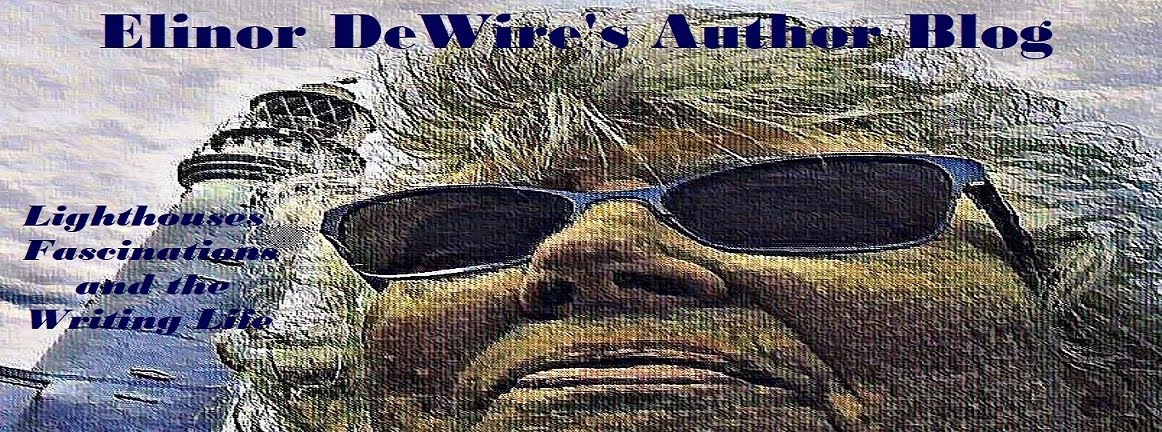First among the Gothic sentinels was Mare Island Lighthouse in San Francisco, inaugurated in 1873 and pictured above (collection of the Coast Guard Archives). It was discontinued and razed in favor of a lighthouse in Carquinez Strait.
Next to be lighted was East Brother Island Lighthouse. It's still working and doubles as a B&B off Point Richmond, California. It was placed in service March 1, 1874. Today, it's a charming destination. The caretakers sometimes fire off the old fog signal for visitors and B&B guests.
.
Hereford Inlet Lighthouse was lighted a month later on March 30, 1874. It was the only Gothic lighthouse on the East Coast. It stands at Wildwood, New Jersey. It's a well-kept museum today, the highlight being its impeccably groomed gardens. I spent a wonderful day here in October in the late 1990s during New Jersey's "Lighthouse Challenge," signing books on the porch and meeting visitors. Jon snapped the photo below at the front gate. The bottom photo is courtesy of the New Jersey Lighthouse Society, sponsor of the annual "Lighthouse Challenge." It shows the plank boardwalk over the sand and some of the garden plantings.
Point Hueneme Lighthouse in Southern California had its beginnings as a Carpenter Gothic structure. Today the tower is a modern Art Deco structure. The original sentinels was much prettier, though no more functional than the current lighthouse. We need to remember that a lighthouse doesn't have to be beautiful to do good work. The historic photo of the original Point Hueneme Light is reproduced on a postcard. Below it is the modern concrete lighthouse now on duty. It serves as a museum.
Another lighthouse of Pelz's unique Gothic design was Point Fermin Light at San Pablo, California. This lovely old sentry is a museum today, with a rich maritime history. It had several women keepers, including Thelma Austin. Her grand-niece is active with the lighthouse restoration and operation. The grounds are well-kept, and the docents are knowledgeable and friendly. The photo below was taken by my friend Derith Bennett about 2005 when the two of visited the lighthouse.
Point San Luis Lighthouse at San Luis Obispo, California is another Gothic beauty. It was built in 1890. It has been lovingly restored and is open for tours by special arrangement. Accessing the lighthouse requires permission, as the road is narrow and travels along a steep cliff adjacent to a power plant. I visited the site about eight years ago. A highlight was seeing the old concrete cistern and rainwater catchment area behind the lighthouse. This is a dry area, and water was needed not only for the household but for the fog signal machinery to produce steam. Some of the water was caught on the roofs of the buildings. The catchment area is a broad concrete pad sloped toward the cistern. You can see the roof catchment system in the historic photo below from the Coast Guard Archives. The bottom image is from my friend Kraig Anderson (www.lighthousefriends.com).
Table Bluff Lighthouse at Humboldt Bay was of the same design as Point San Luis Light. It was first lighted in 1892 and was, at first, called Humboldt Bay Lighthouse (pictured below courtesy of the Coast Guard Archives). Later, to avoid confusion with the old light at Humboldt Bay, the name became Table Bluff Light. In the 1950s the site underwent physical changes, with only the square tower left and then, eventually, a skeleton tower to replace it. Table Bluff Light was deactivated completely in 1975. The square tower was moved Woodley Island Marina in 1987 to be used as a decorative piece. It's still there and is shown in a 2011 photo by The Lighthouse People, Bob and Sandra Shanklin. (www.thelighthousepeople.com)
Ballast Point Light was of the same design. It stood guard over the old whaling station at San Diego Bay and was first placed in service in 1888. It was discontinued many years ago. The archival photo below is from the Coast Guard Archives. It shows the lightkeeper and his family and the second dwelling in the background.

























